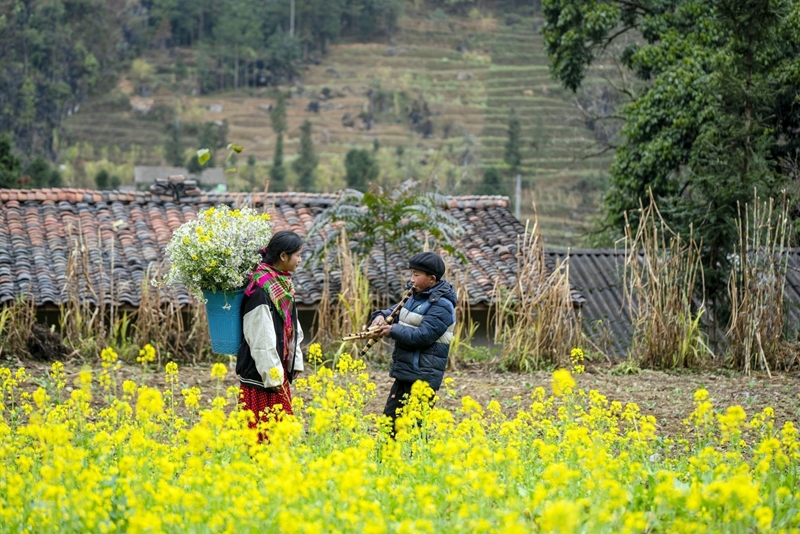The Dong Van Karst Plateau UNESCO Global Geopark in the northern province of Tuyen Quang was named “Asia’s Leading Regional Cultural Destination,” meanwhile Phong Nha - Ke Bang National Park in the central province of Quang Tri claimed a double victory as “Vietnam’s Leading Natural Destination” and “Asia’s Leading National Park 2025”.
The World Travel Awards, established in 1993, are widely regarded as the “Oscars of the travel industry,” celebrating outstanding brands, organizations, and businesses in travel, aviation, hospitality, service, and destination management across Asia and Oceania.
Dong Van – one of Asia’s most beloved green and culturally-rich destinations
The Dong Van Karst Plateau UNESCO Global Geopark has consistently been honored by the World Travel Awards (WTA), earning titles such as “Asia's Leading Emerging Tourism Destination 2023” and “Asia's Leading Cultural Destination 2024”.
Covering over 234,500 hectares, the site preserves geological layers dating back more than 500 million years, showcasing the imprints of Earth’s tectonic movements that have created a rare and living geological museum in the world. Home to 17 ethnic minority groups, whose distinctive cultural identities are well maintained over generations, the plateau is a natural wonder and a cultural treasure of Vietnam.
    |
 |
|
Beauty of Dong Van Karst Plateau |
In 2010, the Dong Van Karst Plateau was recognized by UNESCO as the first Global Geopark of Vietnam and the second in Southeast Asia. Over the past nearly 15 years, with three successful revalidations, the plateau has become a must-visit destination for both scientists and tourists.
With 59 heritage sites organized into four distinct experiential routes, the park has been recognized by UNESCO as a Global Geopark since 2010, highlighting its international scientific, educational, and aesthetic value. The area features dramatic landscapes, including sharp limestone peaks, deep valleys, sheer cliffs, and a limestone cave system.
The area preserves many paleontological fossils and significant tectonic heritage sites, such as the fault escarpments in Quan Ba commune, which reflect over 500 million years of Earth’s formation history. This setting supports the development of geotourism that integrates geological exploration with environmental and cultural experiences.
The Dong Van Karst Plateau is home to 17 ethnic minority groups, including the H'mong, Dao, Lo Lo, and Tay, contributing to a rich and diverse cultural heritage. Many communities have preserved unique traditional customs, with vibrant festivals such as The Phong Luu Khau Vai Love Market, The H'mong Panpipe Festival, and Buckwheat Flower Festival, attracting numerous visitors. The area also features historically significant sites, including the Lung Cu Flag Tower - the northernmost point of Vietnam, the Vuong Mansion in Sa Phin commune, as well as the French Fort and the Lung Ho Citadel.
Nguyen Thi Hoai, Deputy Director of Tuyen Quang’s Department of Culture, Sports and Tourism, highlighted the province’s goal of promoting sustainable tourism that preserves its geological, cultural, and ecological heritage, focusing on geotourism, cultural–historical tourism, community-based tourism, and experiential travel. The province is also enhancing transport infrastructure, service systems, and local tourism workforce training to raise service quality while ensuring safety, attractiveness, and hospitality. By 2030, Tuyen Quang aims to elevate the Dong Van Karst Plateau UNESCO Global Geopark into a national tourism destination and position tourism as a key economic sector built on sustainability, traditional cultural preservation, professionalism, quality, and efficiency.
Phong Nha – Ke Bang shines on Asia’s tourism map
The Phong Nha–Ke Bang National Park, spanning more than 201,000 hectares, is one of Vietnam’s most unique and biodiverse reserves. It is famous for hundreds of magnificent caves, and a unique ecosystem of the limestone mountains in the northern Truong Son region. Not only renowned for its rich biodiversity and stunning natural landscapes, but the park is also famous for its vast cave system, earning it the title “The Kingdom of Caves” in the world.
The park was twice recognized by UNESCO as a World Natural Heritage Site, first in 2003 for its geological and geomorphological values, and again in 2015 for its exceptional biodiversity.
The Phong Nha–Ke Bang National Park has been recognized twice by UNESCO as a World Natural Heritage site. In 2003, it was inscribed for its geological and geomorphological values, and in 2015, it received its second recognition for its outstanding biodiversity.
Pham Hong Thai, Director of the Phong Nha - Ke Bang National Park Management Board, said that the twin victories at WTA 2025 mark “a historic milestone,” opening a new era of development, elevating the Phong Nha - Ke Bang brand on the map of high-end tourism in Asia and worldwide.
Recognition at both national and regional levels marks a transformative moment for Phong Nha - Ke Bang, elevating it from a pristine “hidden gem” favored by adventurous travelers to a leading luxury eco-destination attracting international visitors. This opens up opportunities to attract strategic investors and develop premium products such as eco-resorts, wellness retreats, and exclusive exploration tours. It also offers Quang Tri an opportunity to reposition its tourism model, moving from simple “ticket sales” to immersive and experience-driven offerings such as expert-led cave expeditions, forest survival workshops, professional photography tours, and nature-centered wellness retreats.
Thai stressed that the award is not a final destination but rather a new beginning, reaffirming the province’s commitment to sustainable tourism and heritage conservation.
In the first nine months of 2025, Phong Nha - Ke Bang National Park welcomed more than 836,900 visitors, including over 148,000 international travelers, up 18% year-on-year. The Phong Nha Tourism Centre remained the most visited site with over 481,000 arrivals, followed by the Thien Duong (Paradise) Cave Ecotourism Area with nearly 298,000 visitors.
Source: VNA